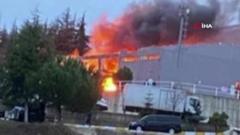The object, known as a bolide, is a fireball that explodes with a brilliant flash, thrilling onlookers and sparking widespread fascination and discussion across social media platforms.
**A Stunning Bolide Lights Up the Skies Above Mexico City**

**A Stunning Bolide Lights Up the Skies Above Mexico City**
A bright fireball captured the awe of residents and online viewers as it blazed through Mexico's skies on Wednesday morning.
On Wednesday, a brilliant fireball, identified as a bolide, dramatically illuminated the early morning skies near Mexico City, captivating not only local residents but also sparking excitement among online viewers. Witnesses quickly shared videos of the dazzling display, which has since gone viral.
According to a report by The Associated Press, bolides are known for their peculiar, bright explosions, often accompanied by fragments. Jérôme Gattacceca, editor of The Meteoritical Bulletin, clarified that while meteors become meteorites upon reaching the Earth's surface, bolides are simply the bright phenomena observed when these objects enter the atmosphere.
Dr. Gattacceca explained that meteors can be classified as "fireballs" if they shine brighter than Venus in the night sky. Although meteors and fireballs occur regularly, bolides are less common yet still not an anomaly. Guadalupe Cordero Tercero, a researcher at UNAM's Institute of Geophysics, noted estimates suggesting that approximately one meter-sized object enters the Earth's atmosphere every two and a half days, with most landing unnoticed in oceans or unpopulated regions.
Denton Ebel, a noted meteorite curator, stated that the reports of the sudden fireball create excitement and indicate active observation of such events, as fireball networks across cities capture these occurrences with specialized cameras. UNAM Global Magazine described the fireball's descent as thunderous, emitting a sonic boom during its fragmentation, indicative of meteorites potentially reaching the ground.
These space rocks, coming primarily from the asteroid belt, can generate fireballs at high velocities, even if they are small in size. Despite the spectacle, Dr. Gattacceca reassured viewers that the event posed no danger; historically, no deaths have been recorded due to falling meteorites.
With over 22 million residents in the vicinity, the breathtaking display provided a sense of wonder rather than fear, showcasing nature's awe-inspiring phenomena.
According to a report by The Associated Press, bolides are known for their peculiar, bright explosions, often accompanied by fragments. Jérôme Gattacceca, editor of The Meteoritical Bulletin, clarified that while meteors become meteorites upon reaching the Earth's surface, bolides are simply the bright phenomena observed when these objects enter the atmosphere.
Dr. Gattacceca explained that meteors can be classified as "fireballs" if they shine brighter than Venus in the night sky. Although meteors and fireballs occur regularly, bolides are less common yet still not an anomaly. Guadalupe Cordero Tercero, a researcher at UNAM's Institute of Geophysics, noted estimates suggesting that approximately one meter-sized object enters the Earth's atmosphere every two and a half days, with most landing unnoticed in oceans or unpopulated regions.
Denton Ebel, a noted meteorite curator, stated that the reports of the sudden fireball create excitement and indicate active observation of such events, as fireball networks across cities capture these occurrences with specialized cameras. UNAM Global Magazine described the fireball's descent as thunderous, emitting a sonic boom during its fragmentation, indicative of meteorites potentially reaching the ground.
These space rocks, coming primarily from the asteroid belt, can generate fireballs at high velocities, even if they are small in size. Despite the spectacle, Dr. Gattacceca reassured viewers that the event posed no danger; historically, no deaths have been recorded due to falling meteorites.
With over 22 million residents in the vicinity, the breathtaking display provided a sense of wonder rather than fear, showcasing nature's awe-inspiring phenomena.







